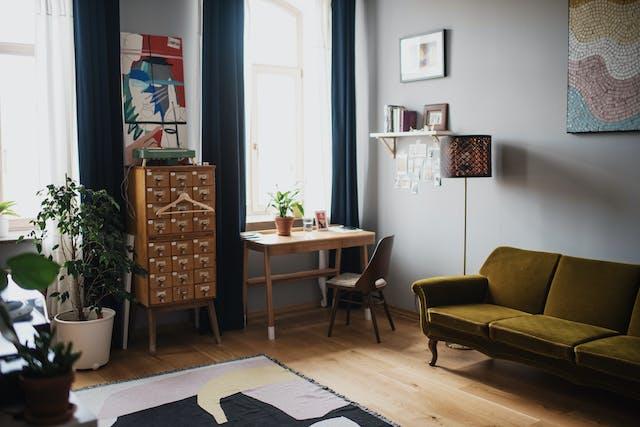
Benefits of Natural Lighting in Home Decor:
Natural lighting has both psychological and physiological benefits that contribute to a healthy and visually pleasing living environment. Here are some of the key benefits: Enhances Mood and Productivity:Natural light has been shown to positively affect mood and increase productivity. Exposure to natural light triggers the release of serotonin, a neurotransmitter responsible for promoting feelings of happiness and well-being. This can lead to improved focus, concentration, and overall productivity in your home. Tips for maximizing natural light:
- Optimize window placement: Arrange furniture and decor in a way that does not obstruct natural light from entering the room. Avoid placing large pieces of furniture directly in front of windows.
- Use light-colored furnishings: Choose light-colored furniture, such as white or pastel shades, that reflect natural light and make the room feel brighter and more spacious.
- Utilize mirrors: Hang mirrors strategically across from windows to reflect and amplify natural light, making the room appear bigger and brighter. Creates a Welcoming and Inviting Atmosphere:
Natural light has a warm and inviting quality that artificial lighting cannot replicate. It creates a sense of openness and connection to the outdoors, making a room feel more welcoming and comfortable. Tips for maximizing natural light:
- Use sheer curtains or blinds: Opt for sheer curtains or blinds that allow natural light to filter through while still providing privacy. Avoid heavy or dark-colored window treatments that can block out light.
- Keep windows clean: Regularly clean your windows to remove dirt and grime that can obstruct natural light. Sparkling clean windows allow maximum light to enter the room.
- Utilize skylights or light tubes: If possible, consider installing skylights or light tubes in rooms with limited access to natural light. These can be excellent sources of natural light, especially in areas like bathrooms or hallways.
Promotes Energy Efficiency and Sustainability:
Natural lighting reduces the need for artificial lighting during the day, leading to significant energy savings and a smaller carbon footprint. By relying more on natural light, you can reduce your electricity consumption and contribute to a more sustainable home.
Tips for maximizing natural light:
- Remove obstacles outside windows: Trim trees or bushes that may be blocking natural light from entering your home. Keep outdoor spaces clean and clutter-free to allow light to pass through freely.
- Choose light-reflective surfaces: Opt for light-reflective surfaces, such as glossy or satin finishes on walls, ceilings, and floors. These surfaces bounce natural light around the room, increasing its overall brightness.
- Consider light-colored paint: Use light-colored paint on walls and ceilings to help distribute and amplify natural light. Lighter shades reflect light better than darker ones, making the room feel brighter.
Designing with Natural Lighting in Mind:
Maximizing natural light goes beyond simply opening curtains or blinds. It involves strategic design choices that enhance the flow and distribution of light throughout your living space.Tips for designing with natural lighting in mind:
- Open floor plan: Consider an open floor plan that allows natural light to flow freely between rooms. Removing walls or using partial walls or dividers can create a more spacious and light-filled environment.
- Use light-reflective materials: Incorporate light-reflective materials, such as glass, mirrors, and metallic finishes, in your home decor. These materials help bounce light around the room, creating a brighter and more expansive feel.
- Consider window placement and size: When designing or renovating your home, consider the placement and size of windows to maximize natural light. Larger windows, strategically placed to capture the most sunlight, can dramatically improve the amount of light in a room.
- Incorporate light wells or atriums: If possible, consider incorporating light wells or atriums that bring natural light into interior spaces. These architectural features can create a stunning focal point and flood the surrounding areas with natural light.
Maintaining a Balance of Natural and Artificial Lighting:
While natural lighting is highly desirable, it is important to strike the right balance between natural and artificial lighting to ensure optimal functionality and aesthetics in your living space.Tips for maintaining a balance of lighting:
- Layer lighting sources: Combine natural light with artificial lighting to create a layered and versatile lighting scheme. Use a combination of ambient, task, and accent lighting to meet different needs throughout the day and evening.
- Install dimmers: Use dimmer switches to control the intensity of artificial lighting. This allows you to adjust the lighting levels based on the amount of natural light available, creating a more comfortable and cozy atmosphere.
- Choose warm-toned artificial lighting: Opt for warm-toned light bulbs, such as those labeled "soft white" or "warm white," to mimic the warmth of natural light. This creates a cohesive and harmonious lighting environment.
- Use directional lighting: Incorporate adjustable or directional lighting fixtures, such as track lighting or recessed lights, to highlight specific areas or objects in the room. This can help compensate for areas with limited natural light.
Maximizing natural light in your living space not only enhances the aesthetics and overall ambiance but also contributes to your well-being and energy efficiency. By understanding the benefits of natural lighting and implementing strategies to maximize its potential, you can create a bright, inviting, and visually appealing home. Consider the tips provided, such as optimizing window placement, using light-reflective surfaces, and designing with natural lighting in mind, to create a space that is filled with the beauty and benefits of natural light. Remember to strike a balance between natural and artificial lighting, ensuring optimal functionality and comfort in every corner of your home.
Article
Be the first comment














